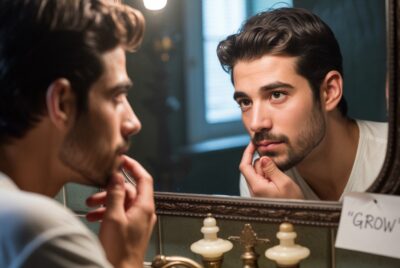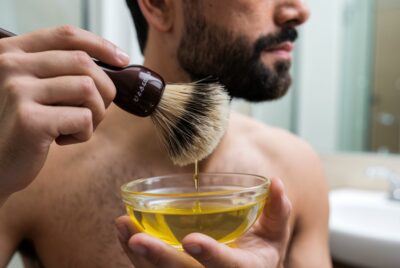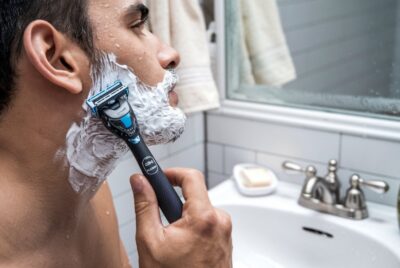Manscaping Guide: Safe Grooming for Chest, Back & Private Areas
Post Disclaimer
*We may earn a commission for purchases made using our links. Please see our disclosure to learn more.
Modern men are increasingly embracing personal grooming as part of their self-care routine. What was once considered taboo or purely aesthetic has evolved into a practice that combines hygiene, comfort, and confidence. The art of manscaping—strategic body hair grooming—has become as routine as trimming facial hair for many men seeking to look and feel their best.
The journey toward effective body grooming often begins with uncertainty and apprehension. Many men find themselves standing in the bathroom, razor in hand, wondering where to start and how to avoid the painful mistakes that seem inevitable. The fear of cuts, irritation, and awkward conversations with partners can make this essential grooming practice seem daunting.
However, with proper technique, quality tools, and realistic expectations, manscaping transforms from a nerve-wracking chore into an empowering routine that enhances both physical comfort and self-confidence. The key lies in understanding that safe, effective body hair management is a skill that develops over time, requiring patience, practice, and the right approach.
“Personal grooming is not about conforming to standards, but about feeling comfortable and confident in your own skin.”
– Men’s Health Research Institute
Key Takeaways
- Safety First: Proper preparation and technique prevent injuries and irritation
- Tool Selection Matters: Investing in quality grooming tools designed for body hair makes a significant difference
- Gradual Approach: Starting with trimming before moving to shaving reduces risk and builds confidence
- Skin Care is Essential: Pre and post-grooming care prevents irritation and maintains healthy skin
- Individual Preferences Vary: Finding your personal grooming style takes time and experimentation
Understanding the Manscaping Landscape
Body hair serves various biological purposes, from temperature regulation to protection against friction. However, modern lifestyle preferences, athletic performance considerations, and personal comfort often motivate men to modify their natural hair patterns. The decision to engage in manscaping represents a personal choice that should be approached with knowledge and care.
The grooming industry has responded to this growing interest with specialized tools and products designed specifically for male body hair. Unlike facial hair, body hair varies significantly in texture, density, and sensitivity depending on the location. Chest hair tends to be coarser than arm hair, while pubic hair requires entirely different handling than leg hair.
Understanding these differences forms the foundation of effective manscaping. Each area of the body presents unique challenges and requires tailored approaches. The skin on the back differs from chest skin in terms of accessibility and sensitivity, while intimate areas demand the highest level of care and precision.
Essential Tools for Safe Manscaping
Professional-Grade Trimmers
Quality body hair trimmers serve as the cornerstone of any manscaping routine. Unlike standard hair clippers, body groomers feature guards designed to prevent skin contact while maintaining cutting efficiency. Look for waterproof models that can be used in the shower, as wet trimming often provides better control and comfort.
Variable length settings allow for customization based on personal preference and body area. Chest hair might look best at a moderate length, while back hair often benefits from closer trimming. The ability to adjust length settings ensures consistency and prevents the patchy appearance that can result from uneven cutting.
Specialized Razors and Shaving Tools
When trimming isn’t sufficient, specialized razors designed for body use provide the next level of grooming. These tools typically feature multiple blades, moisturizing strips, and ergonomic handles that facilitate use in hard-to-reach areas. Single-blade safety razors offer increased control for experienced users, while multi-blade cartridge systems provide convenience and built-in protection features.
Electric shavers designed for body use incorporate safety features like rounded heads and flexible cutting surfaces. These tools excel in areas where traditional razors might cause nicks or cuts, particularly for beginners still developing their technique.
Preparation and Aftercare Products
Pre-shave oils help soften hair and create a protective barrier between skin and blade. High-quality shaving creams or gels provide lubrication and cushioning during the shaving process. Post-shave balms and moisturizers soothe irritated skin and prevent ingrown hairs.
Exfoliating products remove dead skin cells and help prevent ingrown hairs, particularly important in areas prone to friction. Antiseptic products provide additional protection against infection, especially relevant when dealing with minor nicks or cuts.
Chest Hair Grooming Techniques
Assessment and Planning
Chest hair patterns vary dramatically among individuals, from sparse growth to dense coverage extending from collarbone to abdomen. Before beginning any grooming routine, assess the natural growth pattern and density. This evaluation helps determine whether trimming, partial removal, or complete removal best suits individual preferences and lifestyle needs.
Consider the overall aesthetic goal. Some men prefer a natural look with strategic trimming to reduce bulk, while others opt for complete removal. The choice often depends on personal preference, partner preferences, athletic requirements, or seasonal considerations.
Safe Trimming Methods
Begin chest grooming with trimming rather than immediate shaving. Set the trimmer to a longer guard setting initially, gradually reducing length until achieving the desired appearance. Work in sections, moving systematically from one side of the chest to the other to ensure even results.
Pay special attention to the transition areas where chest hair meets arm hair and abdominal hair. Creating natural-looking transitions prevents the obviously groomed appearance that can result from sharp demarcation lines. Blend these areas by gradually increasing hair length as you move away from the primary grooming area.
Shaving Techniques for Smooth Results
When complete hair removal is desired, preparation becomes crucial. Trim hair to approximately one-quarter inch before shaving to prevent clogging and improve razor efficiency. Take a warm shower or apply warm compresses to soften hair and open pores.
Apply pre-shave oil followed by a generous layer of shaving cream or gel. Use light, short strokes with minimal pressure, allowing the razor to do the work. Shave in the direction of hair growth initially, then against the grain only if necessary for closer results.
Rinse the razor frequently to prevent clogging and maintain cutting efficiency. After completing the shaving process, rinse with cool water to close pores and apply aftershave balm to soothe skin and prevent irritation.
Back Hair Management Strategies
Accessibility Challenges
Back hair grooming presents unique logistical challenges due to limited reach and visibility. Most men cannot effectively groom their own back hair without assistance or specialized tools. This reality often makes back hair management the most frustrating aspect of manscaping.
Professional grooming services offer one solution, providing expertise and access that individual grooming cannot match. However, cost and convenience factors make this option impractical for regular maintenance. Understanding the available alternatives helps men choose the approach that best fits their lifestyle and budget.
Partner Assistance Approach
Enlisting a partner’s help often provides the most effective solution for back hair management. Clear communication about preferences, concerns, and comfort levels ensures positive outcomes for both parties. Provide guidance about desired hair length and areas requiring attention while maintaining realistic expectations about results.
Create a comfortable environment with good lighting and necessary supplies within easy reach. Consider this shared activity as an opportunity for bonding rather than a chore, maintaining open communication throughout the process about comfort levels and technique adjustments.
Professional Solutions
Professional waxing services offer longer-lasting results compared to shaving, with hair regrowth typically occurring over several weeks rather than days. However, waxing requires sufficient hair length for effective removal and can be painful, particularly for first-time clients.
Laser hair removal provides the most permanent solution for back hair concerns, though it requires multiple sessions and significant financial investment. This option works best for men committed to long-term hair reduction rather than those experimenting with grooming preferences.
Private Area Grooming: Safety and Technique
Understanding Sensitivity and Anatomy
Intimate area grooming requires the highest level of care and attention due to skin sensitivity and anatomical complexity. The pubic region features varying hair textures, skin thickness, and sensitivity levels that demand specialized techniques and tools.
Different areas within the private region require different approaches. The pubic mound can typically handle more aggressive grooming techniques, while the scrotum and perineum require gentler methods. Understanding these differences prevents injury and ensures comfortable results.
Preparation Protocols
Thorough preparation becomes even more critical when grooming intimate areas. Begin with a warm shower to soften hair and relax skin. Consider using a mirror to improve visibility and precision during the grooming process.
Trim longer hairs with scissors or a trimmer before attempting to shave. This preliminary step prevents razor clogging and reduces the risk of painful pulling. Take time to inspect the area for any skin irregularities, moles, or sensitive spots that require special attention.
Safe Shaving Techniques
Use a fresh, sharp razor specifically designated for body use. Dull blades increase the risk of cuts and irritation in these sensitive areas. Apply generous amounts of shaving cream or gel, reapplying as needed throughout the process.
Maintain skin tension by gently stretching skin taut while shaving. This technique provides a smoother surface for the razor and reduces the risk of cuts. Use light pressure and short strokes, working carefully around anatomical curves and sensitive areas.
Pay particular attention to grain direction, as pubic hair often grows in multiple directions within small areas. Begin shaving with the grain, only attempting against-grain passes in areas where closer results are necessary and skin tolerance allows.
Managing Common Challenges
Dealing with Irritation and Ingrown Hairs
Post-grooming irritation represents one of the most common manscaping challenges. Red bumps, itching, and general discomfort can make the grooming experience unpleasant and discourage continued practice. Understanding prevention and treatment strategies helps maintain consistency in grooming routines.
Ingrown hairs occur when cut hair grows back into the skin rather than emerging normally. This problem particularly affects areas with curly or coarse hair, such as the pubic region and chest. Regular exfoliation helps prevent ingrown hairs by removing dead skin cells that can trap emerging hair.
Addressing Cuts and Minor Injuries
Despite careful technique, minor cuts and nicks occasionally occur during manscaping. Immediate proper care prevents infection and promotes quick healing. Clean any cuts with antiseptic and apply pressure to stop bleeding.
Avoid applying aftershave products containing alcohol directly to cuts, as this can cause excessive stinging and potential tissue damage. Instead, use gentle antiseptic products designed for sensitive skin areas.
Maintaining Consistency and Motivation
Establishing a sustainable grooming routine requires balancing personal preferences with practical considerations like time, cost, and comfort. Many men begin with ambitious grooming goals that become difficult to maintain over time.
Start with simple, achievable grooming goals and gradually expand the routine as comfort and skill levels increase. This progressive approach prevents overwhelming feelings that can lead to abandoning grooming efforts entirely.
Long-term Maintenance and Lifestyle Integration
Developing Personal Grooming Standards
Effective manscaping involves developing personal standards that balance aesthetic preferences with practical considerations. These standards evolve over time as experience grows and life circumstances change. What works for a single man may require adjustment when entering a relationship, and athletic pursuits may influence grooming decisions.
Regular assessment of grooming routines ensures they continue meeting current needs and preferences. Seasonal adjustments often make sense, with more extensive grooming during summer months when less clothing is worn, and simplified routines during colder periods.
Building Sustainable Habits
Consistency in manscaping requires integrating grooming activities into existing routines rather than treating them as separate, time-consuming tasks. Many men find success incorporating body grooming into shower routines, making the process feel natural and efficient.
Schedule regular grooming sessions based on hair growth rates and personal preferences. Some areas may require weekly attention while others need monthly maintenance. Understanding individual growth patterns helps establish realistic maintenance schedules.
Economic Considerations
Quality grooming tools represent an investment that pays dividends through improved results and reduced long-term costs. While professional-grade trimmers and razors require higher initial expenditure, they typically last longer and perform better than budget alternatives.
Calculate the total cost of different grooming approaches, including tools, products, and potential professional services. This analysis helps determine the most cost-effective approach for individual circumstances and preferences.
Conclusion
Effective manscaping combines proper technique, quality tools, and realistic expectations to create grooming routines that enhance comfort and confidence. The journey toward mastering body hair management requires patience and practice, but the results justify the effort invested in learning proper techniques.
Safety remains the paramount concern throughout all manscaping activities. Taking time to prepare properly, using appropriate tools, and listening to skin reactions prevents most common problems associated with body grooming. Remember that skill development takes time, and expecting perfection immediately often leads to frustration and potential injury.
The most successful manscaping routines adapt to individual needs, preferences, and circumstances rather than following rigid rules. What works for one person may require modification for another, and personal preferences may change over time. Maintaining flexibility in approach while adhering to safety principles creates the foundation for long-term grooming success.
As men continue embracing personal grooming as part of overall self-care, the stigma surrounding body hair management continues diminishing. This cultural shift creates more opportunities for open discussion, shared experiences, and improved techniques that benefit all men interested in optimizing their grooming routines.
Frequently Asked Questions
Q: How often should I trim or shave different body areas?
A: Frequency depends on hair growth rate and personal preference. Most men find chest trimming every 1-2 weeks sufficient, while intimate areas may require weekly maintenance for those preferring minimal hair. Back hair typically needs attention every 2-3 weeks.
Q: Is it normal to experience irritation when starting a manscaping routine?
A: Yes, initial irritation is common as skin adjusts to new grooming practices. Start with longer trim settings and gradually reduce length as skin becomes accustomed to grooming. Most irritation decreases significantly after 2-3 grooming sessions.
Q: What’s the difference between trimming and shaving for body hair?
A: Trimming cuts hair to a shorter length while leaving stubble, reducing bulk without complete removal. Shaving removes hair at skin level for smooth results but requires more maintenance and carries higher risk of irritation and ingrown hairs.
Q: Can I use the same razor for my face and body?
A: While possible, it’s not recommended for hygiene reasons. Body razors encounter different bacteria and skin conditions than facial razors. Using separate tools prevents cross-contamination and allows for tools optimized for different areas.
Q: What should I do if I get a cut while manscaping?
A: Clean the cut immediately with antiseptic, apply pressure to stop bleeding, and avoid harsh aftershave products. Most minor cuts heal within a few days. Seek medical attention for deep cuts or signs of infection like excessive redness, swelling, or pus.




